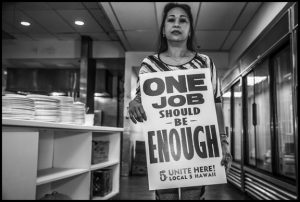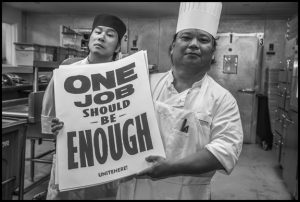
Teachers, parents, and students picket outside City Hall in Los Angeles on Friday, January 18, 2019. (AP Photo / Damian Dovarganes)
How LA’s teachers joined forces with the community and won a landmark labor contract.
By Sarah Jaffe
The Nation
Jan 23, 2019 – On the morning of Friday January 18, the fifth and last full day of the United Teachers Los Angeles strike, some 2,000 parents and students stood hand in hand along Colfax Avenue, creating a chain that stretched nearly a mile, from North Hollywood High to Colfax Elementary to Walter Reed Middle School. They wore red, as they had all week, in solidarity with the educators, and they were jubilant—finally, after a week of very un-LA-like rainy weather, the sun was out. The mood was electric, more so even than when the strike had begun. Partly, it was due to the sunshine, but also to a sense that they were winning.
The parents had organized the action themselves on a Facebook group. Outside Colfax Elementary a parent was cooking—“Eggs for Egducators and Nurishment for Nurses”—on a grill beside a parked pickup truck. A small child darted up and snatched a piece of bacon from the griddle, to everyone’s laughter. Crystal Cruz, a parent with a fifth grader at Colfax and an eighth grader at Walter Reed, told me, “Not everyone can be a teacher. It takes a great deal of patience and fortitude. It takes love for someone else’s children. It takes a lot of resources and talent and time. It is a lot of energy to teach any number of kids in a class, but if you have got 25, that is one thing. If you have got 35, it is a whole other animal.”
Cruz had come out for the teachers, she said, because, “They deserve every respect. They also deserve the financial support. They deserve everything that they are asking for.”
On January 22nd, Cruz’s wishes for the teachers came true. After morning pickets that were joined by Los Angeles firefighters and still more community members, the UTLA held a press conference with Mayor Eric Garcetti and the Los Angeles Unified School District (LAUSD) board superintendent, Austin Beutner, to announce that a tentative agreement had been reached to end the strike. The deal included a 6 percent raise for educators; a reduction in class sizes; a nurse in every school; more funding for librarians, counselors, and wraparound services; a 50 percent reduction in the amount of standardized testing; and more. The union also managed to beat back a two-tier health-care system, while the Board of Education agreed to pursue a cap on charter schools and additional state funding. And the mayor promised to endorse the Schools and Communities First statewide ballot initiative for 2020, which would reform California’s infamous Proposition 13, raising property taxes on corporations to raise money for schools and more.
The look on UTLA president Alex Caputo-Pearl’s face as he announced the contents of the agreement was that of a man who knows his side has won, though he was careful to note that no agreement was final until members got a chance to vote on it. “We are a democratic union,” he told the gathered reporters, explaining that the members would return to their school sites to read the contract and to vote on it using the same structures that had been built to get immediate feedback from the picket lines to union headquarters every day.
In the end, a supermajority of UTLA members voted to approve the agreement that Caputo-Pearl called “Not a narrow labor agreement, but a broad compact.” And indeed, the final deal touched not only on the narrow wages and benefits issues that are so often assumed to be the basis of labor struggles but also on the kinds of far-ranging social and racial justice concerns that have turned teachers’ unions into a full-fledged political movement.
UTLA won its demands after years of reform within the union and in the wake of unrest among teachers nationwide. But most important, the teachers won because of deep, solid community support, mutual organizing, and a sense of shared fate that brought many more people to the streets than there were teachers in the union—60,000 on the Friday before the marathon bargaining weekend that produced the contract. Crystal Cruz was one of these people, as was Amy Schur of the Alliance of Californians for Community Empowerment, or ACCE, one of many organizations that had worked side by side with the teachers in their struggle. “The greatest victory is the power we’ve built through labor and community uniting around a long-term economic, racial and social justice agenda and plan,” said Schur.
Cheyenne McLaren, a student at King/Drew Medical Magnet High and a member of Students Deserve, was another of these fired-up allies. She joined actions last week that ventured beyond the picket line, into the hills, and out to Santa Monica to visit the homes of school-board president Mónica García and superintendent Beutner. “We have a whole plan to get [García] to agree to our demands and see that we are not backing down,” McLaren said at the time. “A lot of people out here are angry.”
McLaren’s organization is part of an even larger group, the Reclaim Our Schools LA coalition, which brings together Students Deserve, ACCE and other community organizations, UTLA, and others to demand funding and support for the schools that serve their neighborhoods. It was Reclaim Our Schools that coordinated the vans and cars to bring over 100 members to the doorsteps of decision-makers like García and Beutner with letters of demands; when the two of them refused to answer their doors, the group held speak-outs on their doorsteps. Outside of Beutner’s gate in Pacific Palisades, the crowd sang “The community is calling” while holding electric candles, as if for a vigil, though the tone was more angry than sad.
“I found out that we had our nurse one day a week and I went to war!” one mother declared. “I have one biological child at that school and 588 adopted children at that school.”
It was that sense—shared by community members and teachers alike—that the children of LA’s public schools are all of their children that animated this strike and made it successful. As Peg Cagle, a math teacher at Reseda High School, said of the weeklong swirl of protest: “After decades of feeling invisible, the fact that you really feel like you are being heard, that your voice is rising above the fold, if you will—you have got a possibility that somehow, somebody, might be listening and somebody might actually pay attention.”
Solidarity doesn’t happen overnight. Despite the elegant—and seemingly effortless—choreography between educators, students, parents, community groups, and even local businesses, the display of community-labor force that rocked LA for more than a week was years in the making, and remarkable in both its breadth and depth. To Amy Schur, who has spent years working in “community-labor” partnerships, this fight “was an incredible example of a union going beyond the rhetoric of working with the community, and actually joining in coalition with parent and community groups as true partners in a long-term fight to save public education.” Because of that real partnership, she said, the victories at the bargaining table were shared by community as well as teachers.
I met Rosa Jimenez in the pouring rain on the fourth morning of the strike, outside of Robert F. Kennedy Community Schools in Koreatown, where she teaches history. She told me—as teachers danced on the picket line to “Proud Mary” and chanted, “We’re soaking wet and really cold! LA schools will not be sold!”—that “everyone is clear about why we’re here.” The organizing and preparation the union had engaged in for months had paid off in an understanding, she said, that, “This is much bigger than us, than our union, even our city. Those of us who work with low-income students of color, we see every day that our students need much more than what they get.”
Jimenez works closely with Reclaim Our Schools LA and with Students Deserve; she was with the students who spoke outside of Beutner’s home, and she was with allies from UNITE HERE when they organized a march from her school to a nearby hotel where the hotel workers were battling for a contract. The students in particular, she said, were inspired by Black Lives Matter’s divest/invest framework, which calls for resources to be taken from policing and prisons and put into schools and community services, and their demands were brought into the union’s bargaining and were won at the table: The union won funding from the district for an immigrant-defense fund, with a dedicated hotline and attorney, and a new program to end random searches in schools.
Those victories “seem little in the scope of things,” Jimenez said, but the district had claimed not long ago that the union could not bargain these issues at all and had even tried to get an injunction against them. “Then we ended up winning on these things. I think it shows the power we had behind us, the parent and student support.”
Jimenez teaches at a school that is seen as a model for the kind of community schools that UTLA and its allies have fought for. What that means, she said, is “teaching curriculum that is culturally relevant, student-centered, and that it is democratically run.” Parents, she said, are involved with decision-making, and students are active participants. The school is also bilingual. “We really have created a place where parents come in and they are with kids in the space until they have to go to class. A lot of parents volunteer.”
Being a community school includes being multicultural and anti-racist, she added. In the age of Trump, that, in turn, has meant considering what it would mean to be a sanctuary school, one that is free of police and ICE so students feel safe—many students, Jimenez said, join the school after leaving immigration detention—as well as a school that could be a hub for organizing in the community. The new contract provides for 30 more community schools like RFK, which Jimenez said was a key demand of Reclaim Our Schools and Students Deserve, and an alternative to the privately-run charters.
“I think it’s huge and it’s really going to change the conversation about what is possible in contract negotiations,” Jimenez said. “It is possible to take on these privatizing forces and it is possible to win and possible to change the narrative. More people are talking about what is at the root of the problems we have in the schools.”
Still, it would be an illusion to suggest that any of this was easy. The community alliances, the solidarity between teachers and students, the support of parents and families, and, of course, the victory—all of this took years of dedicated, patient organizing. And it required real sacrifice, above all by teachers who gave up their pay and risked their jobs to strike—and ultimately won the contract.
“I had this moment this week where I realized, ‘I am also doing this for myself as a worker, as a working-class person, as a single mom,’” Jimenez said, tears in her eyes. “This is actually not that easy for me. I am not getting paid. I am actually also sacrificing. It is okay to say, ‘This is also for me, too.’”
Sarah Jaffe is a fellow at Type Media Center and the author of Necessary Trouble: Americans in Revolt (Nation Books).




